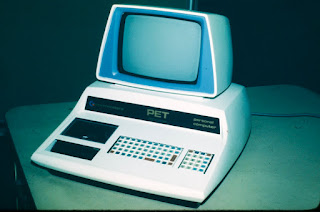Travels with the PET
by Leonard Tramiel
In early 1977 the prototype PET computer, now in the collection of the Computer History Museum in Mountain View, CA, was shown at a large electronics trade show in Hannover, Germany. I was given the task of taking the machine. Since it was a fairly delicate device that used an internal card cage with wire wrapped cards it had a ticket for the seat next to me on the plane.
There was a lot of concern about how to best handle customs going into Germany when we landed in Frankfurt. A customs broker, in addition to a representative of Commodore Germany, tried to meet me to get through customs in time to make my connecting flight to Hannover. This utterly failed. I don't remember all the details but I handed the customs forms I was given to the officials and was told in broken English, "You must pay duty". I said that the machine was only going to be in Germany for the trade show and was told, "You must not pay duty". I was then asked what the device was. This changed the instructions to "You must pay duty". This went on for quite a while.
Unknown to me, the customs broker and Commodore representative were having a similar experience with other officials but they had two big advantages over me. First, there was no language barrier. Second, and not doubt far more important, they knew what they were doing. After a few hours I was allowed to leave the customs area where I was met by someone from Commodore Germany. When I say this was a large trade show that is quite an understatement. The show not only roughly doubles the population of Hannover, it also exhausted the supply of rental cars in Frankfurt. We rented a VW bus and I sat on the floor in the back and kept the PET in my lap to prevent it from sliding around and getting damaged.
We arrived at the Commodore booth just after the Faire had closed for the day. We plugged in the PET and turned it on. It didn't work. A quick examination revealed that the reset button in the back had been ripped loose and only one of the wires was still attached. This PET prototype had a poor relationship with the RESET signal going to the 6502.
The timetable for the development of the PET prototype had a very clear target. The Consumer Electronics Show in Chicago in early January. With only a few days to spare, everything worked, well almost. The PET was developed using a device called the MDT (Microprocessor Development Terminal). The MDT was plugged into the socket that would hold the 6502 and it allowed debugging of the system. The machine worked just fine with the MDT acting as the processor but when a real 6502 was used nothing worked. After a few frantic days it was decided that the PET would not be shown on the show floor while plugged into the MDT but would instead be demoed only in the Commodore suite at one of the convention hotels. The machine, despite the MDT, was a big hit. Not long after getting back to California the cause of the problem was discovered. The RESET pin on the 6502 is connected to 0 volts to reset the system. To allow multiple circuits to cause a reset none of them supply the 5 volt level that allows normal operation. This is provided by what is known as a pull-up resistor. The prototype PET was missing that device. The MDT had one built in so the system worked anyway, if the MDT was used. A pull-up was added to the prototype and it worked.
Until the reset switch broke loose. After an international phone call and a search for a soldering iron, the machine was repaired and we left to go to the hotel.
Until the reset switch broke loose. After an international phone call and a search for a soldering iron, the machine was repaired and we left to go to the hotel.
The PET caused a lot of excitement. Some of Commodore Germany's management was from HP and there was a steady stream of people from HP and other companies coming by the booth to see the PET. Most stood silently and watched me demo the machine, asked a few questions, and left shaking their heads in disbelief.
After the Faire the PET and I were brought to London and hosted by Commodore UK. There were more demos given for the UK press as well as various retailers. It made quite an impression there as well.
Photo by John Feagans. The PET prototype May, 1977.


